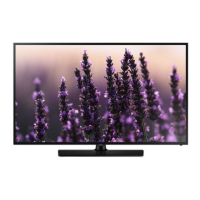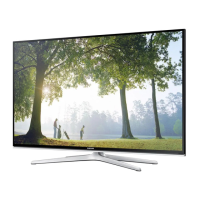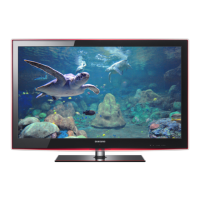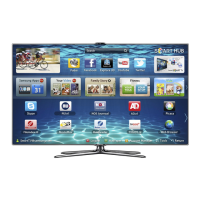Do you have a question about the Samsung UE40H5500AW and is the answer not in the manual?
Warning about opening the product and user-serviceable parts.
Covers ventilation, placement, liquid exposure, and battery handling.
Details about power cords, outlets, metallic objects, and wet hands.
Lists the items typically included with the TV.
Warning about screen damage from direct pressure during handling.
Describes the function and usage of ferrite cores for cable interference.
Guidance to assemble the stand using provided instructions and accessories.
Warning about potential injury or damage from incorrect wall mounting.
Steps to install the optional wall mount kit, recommending professional help.
Details on VESA mounting standards and screw compatibility for wall mounts.
Maintain 10 cm distance for airflow to prevent overheating and fire risk.
Recommendation to use only Samsung parts for installation to avoid product issues or injury.
TV appearance may differ from manual images based on the model.
Caution that some TV parts may be hot to the touch.
Step-by-step guide to install an anti-fall device for TV stability and safety.
Instructions on how to use the cable holder for organizing cables.
Guide on connecting a CI card adapter and card to the TV's common interface slot.
Explains how to use CI/CI+ cards for paid channels and signal reception.
Key information regarding obtaining, handling, and compatibility of CI/CI+ cards.
Instructions for connecting the TV to the internet wirelessly via a router.
Details three methods for wired network connection using modems and routers.
Specifies the minimum network speed (10Mbps) and recommended cable type (Cat 7).
Explains the functions of various buttons on the remote control.
Highlights features like Braille points, Football Mode, and virtual remote control.
Guide on inserting AAA batteries and tips for remote control usage.
Instructions on turning the TV on and using the TV's joystick controller.
Steps for initial TV setup and how device connections affect the process.
Steps to change the TV's PIN code and instructions for resetting a forgotten PIN.
How to select connected external devices using the SOURCE button and Tools button.
Details on HDMI-CEC functionality and safely disconnecting USB devices.
Explains controlling external devices with the TV remote, needing an IR extender cable.
Step-by-step guide to connect the IR extender and set up the universal remote.
How to access and navigate the embedded e-Manual for detailed TV features.
Describes how to load pages using keywords and scroll content.
How to use the index page to find relevant information in the e-Manual.
Using the history feature to quickly access previously viewed e-Manual pages.
Directly access TV menus from the e-Manual for feature testing.
Linking to related reference pages from feature descriptions within the e-Manual.
Procedure to update the e-Manual to the latest version via SAMSUNG APPS.
Solutions for the TV not turning on, checking power connections and outlets.
Troubleshooting steps for no picture/video, checking cables and input sources.
Solutions for remote control issues, including battery replacement and sensor cleaning.
How to program a cable/set-top box remote to control the TV.
Explains the Eco Sensor's role in automatically adjusting brightness for power saving.
Caution that blocking the sensor can reduce picture brightness.
Steps to turn the Eco Sensor feature on or off via the System menu.
Details what Samsung's Remote Support service can do for your TV.
Step-by-step process of how remote support is provided by a technician.
How to clean any debris left on the screen after removing a sticker.
Guidelines for cleaning the TV exterior and screen safely without damage.
Details on resolution, operating temperature, humidity, and storage conditions.
Lists model names, screen sizes, dimensions, and weights for different TV variants.
Advice to unplug the TV during long periods of non-use to save power.
Lists trademarks and technologies related to HDMI, audio, and video features.
Warning about displaying static images causing burn-in and recommendations for prevention.
Statement of compliance with EU directives and location of the official declaration.
Note that the equipment is intended for indoor use only.
Instructions for responsible disposal of the product and accessories to protect the environment.
Guidance on proper disposal of batteries, including those containing heavy metals.
| Screen shape | Flat |
|---|---|
| Response time | - ms |
| Display diagonal | 40 \ |
| Display brightness | - cd/m² |
| LED backlighting type | - |
| Supported video modes | 1080p |
| Supported graphics resolutions | 1920 x 1080 (HD 1080) |
| Motion interpolation technology | CMR (Clear Motion Rate) 100 |
| Motion control | No |
| Annual energy consumption | 62 kWh |
| Tuner type | Analog & digital |
| Digital signal format system | DVB-C, DVB-T |
| Audio decoders | Dolby Digital, Dolby Digital DTS |
| RMS rated power | 10 W |
| Number of speakers | 2 |
| HDMI version | 1.4a |
| HDMI ports quantity | 3 |
| DVI-D ports quantity | 0 |
| USB 2.0 ports quantity | USB 2.0 ports have a data transmission speed of 480 Mbps, and are backwards compatible with USB 1.1 ports. You can connect all kinds of peripheral devices to them. |
| Component video (YPbPr/YCbCr) in | 1 |
| Consumer Electronics Control (CEC) | Anynet+ |
| Number of OSD languages | 27 |
| Picture processing technology | Samsung Wide Color Enhancer |
| Product color | Black |
| Panel mounting interface | 200 x 200 mm |
| AC input voltage | 220 - 240 V |
| AC input frequency | 50 - 60 Hz |
| Power consumption (max) | 105 W |
| Power consumption (standby) | 0.3 W |
| Power consumption (typical) | 45 W |
| Power consumption (PowerSave) | 25 W |
| Package depth | 120 mm |
| Package width | 1100 mm |
| Package height | 600 mm |
| Package weight | 10500 g |
| Cables included | IR |
| Depth (with stand) | 196.4 mm |
|---|---|
| Height (with stand) | 578.2 mm |
| Weight (with stand) | 8600 g |
| Depth (without stand) | 65.1 mm |
| Width (without stand) | 906.6 mm |
| Height (without stand) | 532.9 mm |
| Weight (without stand) | 7700 g |












